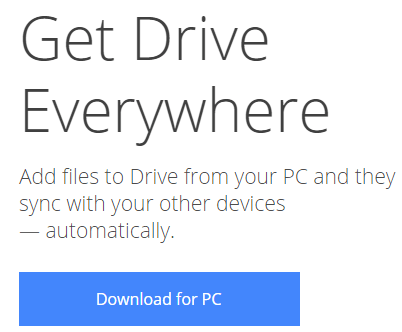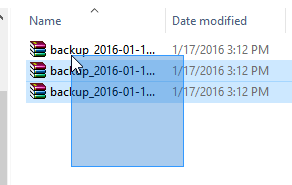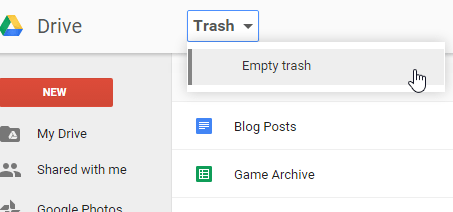Google Drive starts getting clogged up with heaps of useless data. Even though 15GB of storage space may appear to be much larger, it still requires some management, data organization and clean-up on the part of user.
This article primarily focuses on tips to clean up maximum junk from Google Drive as well as sweeping the trash to free up invaluable space for other documents that truly deserve it. For a quick PC and G Drive cleanup, use the ST Cleaner software by Sorcim. It removes troves of useless files and makes your computer run faster. Download it here:

Download Google Drive & PC Cleaner
ST Cleaner Download (w/ Verisign Digital Certificate).
Compatible with Windows 10/8.1/8, Windows 7, Vista/XP.
Symptoms
- Lack of space
- Bloated trash
- Hard to manage, disorganization of online documents
Solutions
Solution 1 : Manual Method
Install the Google desktop client and sync it properly with your Google Drive account as this gives more control to the user over their contents even in the offline mode.
- Visit https://www.google.com/drive/download/ and Download Google Drive
- Install the app using the downloaded setup
- Login to Google Drive once the installation is completed
- Select the Junk files that you think are no longer required and delete every single one of them
Solution 2 : Automated Method
I developed a custom batch script to automatically delete files from the local machine. Once the local files are deleted, your system will sync with the Cloud and soon those files will be erased from Google Drive as well.
Be advised, this script only deletes temp files. If you know about any other junk extensions, enter them after the *.tmp. Make sure to keep the , and use *.extension (format).
@echo off
echo “Please Follow the Instructions as Said”
set /p drive=Please Enter The Drive Letter Where the Google Drive Reside, Example = C ,WARNING TYPE IT CORRECTLY :
%drive%:
set /p path=Please Enter The Path to the Google Drive Without the Drive Letter, Example = UserName\GoogleDrive (so it would come as C:\UserName\GoogleDrive),WARNING TYPE IT CORRECTLY :
cd %drive%:\%path%
del /s /q /f *.temp,*.tmp
pause
- Copy and paste the aforesaid batch script to Notepad and save it as cleaner.bat (Select File Types= All Files to set the extension as cleaner.bat not cleaner.bat.txt)
- Open the Windows Start menu and type “CMD” (without quotations)
- Open Command Prompt from the Search Result and run it as admin
- Paste the script and hit ENTER to execute the command
- This will result in the deletion of all junk files from the given directory and its subdirectories.
Solution 3 : Delete files from the Trash
Cleaning the Trash of Google Drive is pretty easy. The important point to remember over here is that Google Drive’s Trash section also derives its storage space from the capacity Google has provided to you, and there is NO extra space for Trash. So emptying the Trash is as important as removing junk items from Google Drive. Users should also note that once the data is removed from the Trash, it can NEVER be recovered. So be careful while reviewing contents of the Trash folder. And now let’s look at the steps to empty the Trash:
- Visit the following website: https://drive.google.com/drive/u/0/trash
- Locate “TRASH” option from the drop down menu
- Review all the files carefully. Click on the “Trash” option and select “Empty Trash”. This will instantly clean up the trash and retrieve some more space for your Google Drive
" data-author-type="
Warning: Undefined array key "type" in /home1/clonefil/public_html/blog/wp-content/plugins/molongui-authorship/views/author-box/html-layout.php on line 18
" data-author-archived="
Warning: Undefined array key "archived" in /home1/clonefil/public_html/blog/wp-content/plugins/molongui-authorship/views/author-box/html-layout.php on line 19
">
Warning: Undefined array key "id" in /home1/clonefil/public_html/blog/wp-content/plugins/molongui-authorship/views/author-box/html-layout.php on line 39
-"
Warning: Undefined array key "archive" in /home1/clonefil/public_html/blog/wp-content/plugins/molongui-authorship/views/author-box/html-layout.php on line 40
itemscope itemid="" itemtype="https://schema.org/Person" >
Warning: Undefined array key "img" in /home1/clonefil/public_html/blog/wp-content/plugins/molongui-authorship/views/author-box/parts/html-avatar.php on line 4
Warning: Undefined array key "show_social_web" in /home1/clonefil/public_html/blog/wp-content/plugins/molongui-authorship/views/author-box/parts/html-socialmedia.php on line 6
Warning: Undefined array key "show_social_mail" in /home1/clonefil/public_html/blog/wp-content/plugins/molongui-authorship/views/author-box/parts/html-socialmedia.php on line 7
Warning: Undefined array key "show_social_phone" in /home1/clonefil/public_html/blog/wp-content/plugins/molongui-authorship/views/author-box/parts/html-socialmedia.php on line 8
Warning: Undefined array key "type" in /home1/clonefil/public_html/blog/wp-content/plugins/molongui-authorship/views/author-box/parts/html-name.php on line 17
Warning: Undefined array key "type" in /home1/clonefil/public_html/blog/wp-content/plugins/molongui-authorship/views/author-box/parts/html-name.php on line 19
Warning: Undefined array key "type" in /home1/clonefil/public_html/blog/wp-content/plugins/molongui-authorship/views/author-box/parts/html-name.php on line 21
Warning: Undefined array key "archive" in /home1/clonefil/public_html/blog/wp-content/plugins/molongui-authorship/views/author-box/parts/html-name.php on line 37
Warning: Undefined array key "name" in /home1/clonefil/public_html/blog/wp-content/plugins/molongui-authorship/views/author-box/parts/html-name.php on line 41
Warning: Undefined array key "author_box_bio_source" in /home1/clonefil/public_html/blog/wp-content/plugins/molongui-authorship/views/author-box/parts/html-bio.php on line 2
Warning: Undefined array key "bio" in /home1/clonefil/public_html/blog/wp-content/plugins/molongui-authorship/views/author-box/parts/html-bio.php on line 8



